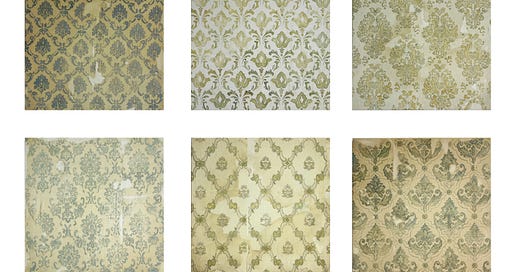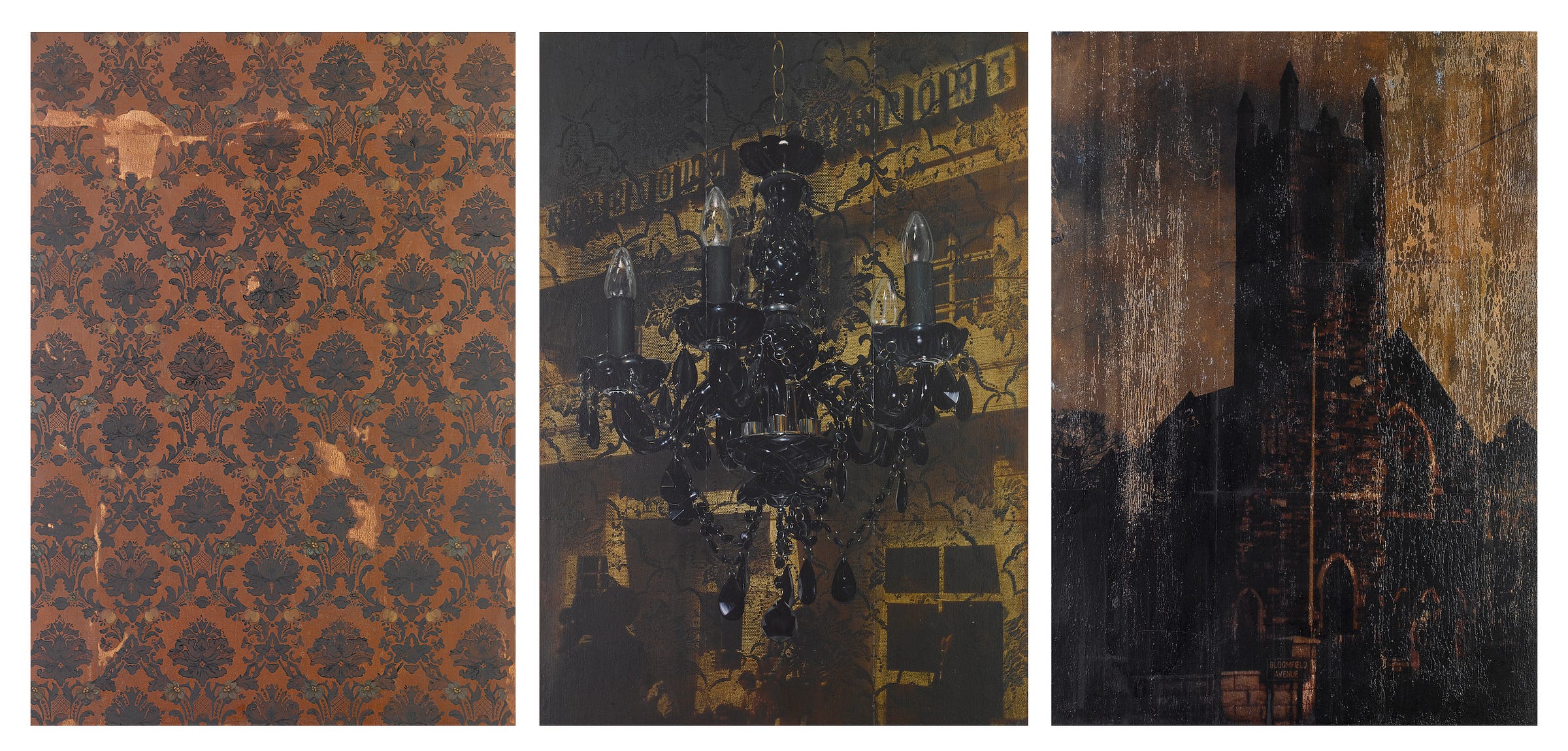If you are a regular or have just landed on Tarantula: Authors and Art, welcome. As our house team of writers joins you on this adventure this year, we hope that the stories we tell as well as the artists we feature will inspire you to start your own creative journeys. If you enjoyed Maja's tale, please leave us a comment, share it with your friends, or subscribe
Wallpaper's history begins in China, where it is said that rice papers were plastered onto walls as far back as the Qin dynasty. The Silk Road brought it to Europe in the 12th century, and the oldest sample is found in 16th century England at Christ College Cambridge. Before it became a symbol of status among the French aristocracy, it was a poor person's method of decorating the walls. The repetitive designs were inspired by textile design and included a cornucopia of fruits, vegetables, birds, animals, leaves, and the highly popular Chinese motifs. Queen Anne imposed a 125-year-long property tax on wallpaper. And in the nineteenth century, one of its biggest producers, the William Morris Company, was accused for the deaths of many children due to the usage of significant amounts of arsenic in its dyes. Wallpapers were not prohibited as a result of the incident; they were made safer ....
What was banned many years later was women's rights to choose or control over their own bodies and lives when they had to terminate their pregnancies in an unsafe manner for whatever reason.. The diverse wallpaper designs, many of which featured religious imagery, may have been the final sights many of the ladies saw before dying as a result of the dangerous conditions.Consider for a moment that these imaginary characters, created by religious men to install fear and control, are peering down from the walls at these helpless women, who are already feeling terrible for breaking the law. Their cloaks, symbols, and haloes serve as persistent reminders of their inability to repent. If only wallpapers could talk.....
Jennifer Trouton's poignant installation at the Supermarket Art Fair in Stockholm this year drew us inside what appeared to be a room from our grandparents' house. We were lulled in by familiar hues, objects such as plates, porcelain bowls, and teacups, and wallpaper designs that were all that familiar. Surrounded by the warm feeling of the booth, we began to notice embroidered flowers known as abortifacients, which assisted women in terminating their pregnancies; long bold crimson threads that represented all the lost blood, all the lost lives. Even though her art is beautiful, Trouton hints about the dangers and horror that often happen in these rooms. With all the polemics about abortion recently, one could think that it is a new method of dealing with unwanted pregnancies. Yet, upon reading the short history of abortion, I realized that it dates back to ancient Egypt, to the year 1550 BCE, when it was recorded in the Ebers Papyrus, the most important medical papyrus of Egyptian herbal knowledge. It was always part of civilized life.
Trouton's finely designed room conveyed not only abortion stories, but also domestic abuse, domesticity, and a sense of helplessness. I had always despised wallpaper, and as I stood in this room, memories of the women who had raised me began to rise.
My first memory of wallpaper takes me to third grade when I changed schools. One of our first painting projects was to paint a portrait of our moms. So I painted mine in the foreground and decorated the backdrop with thick vertical pink and brown stripes interrupted by large flowers. Because all of the other kids had white backgrounds, when they spotted mine, they began chanting that I had put my mother in prison. Even the good-natured teacher's eyes widened when she saw my picture, and she politely suggested that we not hang it up. From the classroom wall, all the other mothers were staring at me, just not mine. If I consider all of my fears about expressing my thoughts and creativity, as well as my fear of being criticized, which has kept me from creating on several occasions, that memory could have been a pivotal moment. But as I stood in Jennifer's booth, my recollections went on even further... I suddenly saw my mother in my grandmother's house, my father's mother's house, where we resided between first and second grade. Maybe the new kids weren't so crazy after all!
The ochre flower like pattern that also reminded of fancy chandeliers repeated itself around the four walls of my grandmother’s room that served as a place of gathering as well as her sleep chambers. The velvety wallpapers absorbed the hundreds of cigarettes she smoked each day. The wallpaper motif slightly yellowed by the nicotine, the smoke always hanging in midair. The TV was always on in her room. She knew all of the old and current movie stars, watched MTV when it finally arrived into her room, even porn when they started broadcasting it at night. She referred to the singer Madonna as ‘that whore.’ I was stunned that she even knew who she was, but I knew that her views were hijacked by current thought on how women should behave and what should they do. There was not so much talk about women supporting women in the early 80’s.
My grandmother used to lay on the sofa that turned into a bed and hardly ever left her room. The already old wallpaper extended into a green carpet, which had many little holes if one looked closer at it. I could imagine her unconsciously drunk, with her long always perfectly painted red fingersnails and her hair put up in a beehive flattened where she met the couch. That room was her prison. My grandfather would take any chance to escape the house and go to his country house. My grandmother was a drunk, often foul mouthed and unbearable to be around. Looking back, I can see that she was possible bipolar or borderline. Standing in Jennifer Trouton’s booth, another memory popped up.
I remembered when my grandmother asked me to help her clean the green carpet. She and I were the only two at home. I agreed …. But my working mom came home early that day and caught us scrubbing the floor. Caught me scrubbing the floor. There was always arguments between the two women, but I have never heard my mom roaring as she did that day before she picked me up from the floor and forbade me to clean. My mother worked as an executive at a firm with thousands of employees while still being a full-time mom, cook, and caregiver when she returned home from work. She shielded me... from domestic life. She never let me do anything around the house.
My grandmother caught up in her own pain as well as her traditional upbringing treated my mom as a slave. That, combined with her alcoholism, made it difficult for me to talk about her .It wasn't until recently, just before my father died, that he revealed my grandmother was put in front of a firing squad while pregnant with him. A Nazi officer approached her at a forced Nazi labor camp and grabbed one of her body parts. She slapped him. He wanted her dead. Another officer rescued her at the last moment, and she was transferred to another camp.
This story made her human in my eyes and not just an evil mother-in law archetype. I started wondering about her life, knowing that I will never get a chance to find out. And that made me think of all the untold stories that have not written down, not painted, not sung about but have hid and gotten lost in meters and meters of wallpaper, and it reminded me of why I swore as a youngster that I would never have wallpaper in my house when I get older. Instead, my walls are now adorned with beautiful pieces of art, each with their own unique tale to tell.
Inspired by Wallpaper Stories
Jennifer Trouton states in her interview with Karen Grace that there are no museums dedicated to abortion and women's stories anywhere in the world. We were a little disappointed after a little investigation and links that lead us to several 'Unfound Pages' on the internet. However, the conversation led Sarah Webb, a reader and Substack writer, to write to us about a project she started called Unspoken, which explored the various ways stories speak through silence and speech. The project provided verbal and visual tropes of women, reflecting on how we have been the custodians of our reproductive health and safety, and will be called upon to do so again in a post-Roe society. Please check it out, and we hope that the brave women's tales will inspire you to share your own with us. Only by sharing these experiences can we safeguard our daughters and encourage our sons to fight alongside them.
ART WORKS
Redrawing the Borders Between the Domestic and the Feminine
FILMS
A Woman Under The Influence
BOOKS
PLAYLIST
Irrelevant by Pink
Papa Don’t Preach by Madonna








